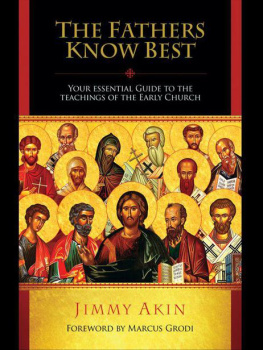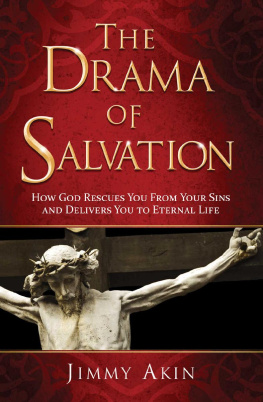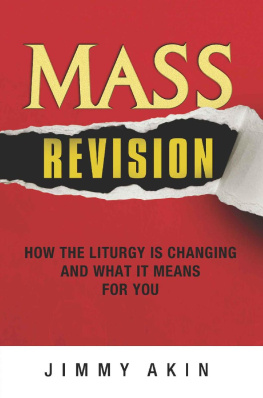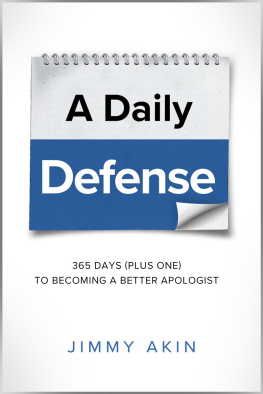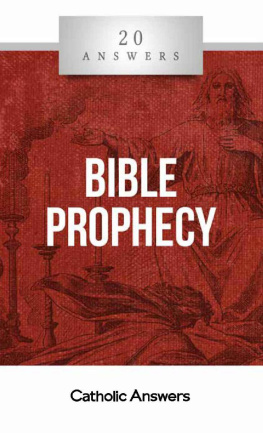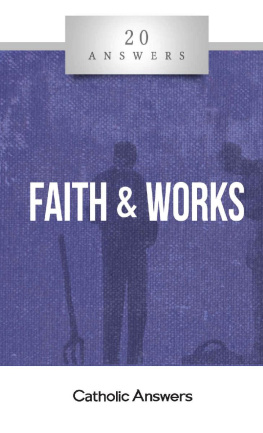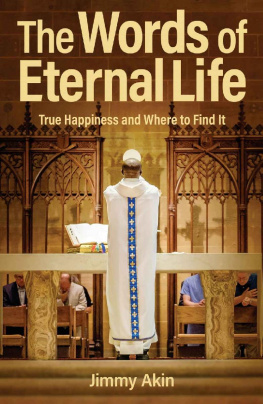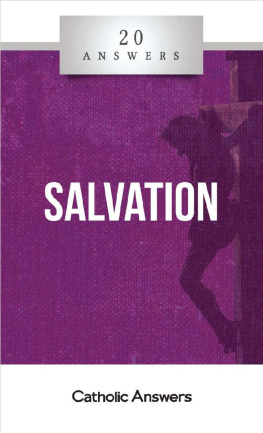Jimmy Akin - Teaching with Authority: How to Cut Through Doctrinal Confusion & Understand What the Church Really Says
Here you can read online Jimmy Akin - Teaching with Authority: How to Cut Through Doctrinal Confusion & Understand What the Church Really Says full text of the book (entire story) in english for free. Download pdf and epub, get meaning, cover and reviews about this ebook. year: 2018, publisher: Catholic Answers Press, genre: Religion. Description of the work, (preface) as well as reviews are available. Best literature library LitArk.com created for fans of good reading and offers a wide selection of genres:
Romance novel
Science fiction
Adventure
Detective
Science
History
Home and family
Prose
Art
Politics
Computer
Non-fiction
Religion
Business
Children
Humor
Choose a favorite category and find really read worthwhile books. Enjoy immersion in the world of imagination, feel the emotions of the characters or learn something new for yourself, make an fascinating discovery.

- Book:Teaching with Authority: How to Cut Through Doctrinal Confusion & Understand What the Church Really Says
- Author:
- Publisher:Catholic Answers Press
- Genre:
- Year:2018
- Rating:3 / 5
- Favourites:Add to favourites
- Your mark:
- 60
- 1
- 2
- 3
- 4
- 5
Teaching with Authority: How to Cut Through Doctrinal Confusion & Understand What the Church Really Says: summary, description and annotation
We offer to read an annotation, description, summary or preface (depends on what the author of the book "Teaching with Authority: How to Cut Through Doctrinal Confusion & Understand What the Church Really Says" wrote himself). If you haven't found the necessary information about the book — write in the comments, we will try to find it.
Jimmy Akin: author's other books
Who wrote Teaching with Authority: How to Cut Through Doctrinal Confusion & Understand What the Church Really Says? Find out the surname, the name of the author of the book and a list of all author's works by series.
Teaching with Authority: How to Cut Through Doctrinal Confusion & Understand What the Church Really Says — read online for free the complete book (whole text) full work
Below is the text of the book, divided by pages. System saving the place of the last page read, allows you to conveniently read the book "Teaching with Authority: How to Cut Through Doctrinal Confusion & Understand What the Church Really Says" online for free, without having to search again every time where you left off. Put a bookmark, and you can go to the page where you finished reading at any time.
Font size:
Interval:
Bookmark:
Teaching with Authority
How to Cut through Doctrinal Confusion & Understand What the Church Really Says
Jimmy Akin
Teaching with Authority
How to Cut through Doctrinal Confusion & Understand What the Church Really Says

2018 Jimmy Akin
All rights reserved. Except for quotations, no part of this book may be reproduced or transmitted in any form or by any means, electronic or mechanical, including photocopying, recording, uploading to the internet, or by any information storage and retrieval system, without written permission from the publisher.
Published by Catholic Answers, Inc.
2020 Gillespie Way
El Cajon, California 92020
1-888-291-8000 orders
619-387-0042 fax
catholic.com
Printed in the United States of America
Cover design by ebooklaunch.com
Interior design by Russell Graphic Design
978-1-68357-094-3
978-1-68357-095-0 Kindle
978-1-68357-096-7 ePub
Dedicated to the memory of Cardinal Avery Dulles, who went out of his way to help me, and in gratitude for the teaching ministry of Joseph Ratzinger/Pope Benedict XVI.
Special thanks to Fr. Hugh Barbour, Mark Brumley, and Professor Janet Smith for assistance with various aspects of this manuscript.
Introduction
There has never been a peaceful time in the history of the Church. From the ministry of Jesus straight through to today, Christians have had to deal with doctrinal conflict, heresy, and dissent.
Throughout the storm, the Holy Spirit has guided the Church and its pastors, providing a clear voice so that the Church serves as the pillar and bulwark of the truth (1 Tim. 3:15).
Yet few people understand their Catholic faith or know how to navigate the complex world of Church documents and teachings .
As part of my professional work, Ive lived in that world for more than twenty-five years. On a daily basis, I work with the details of Church documents and teachings, and Ive long wanted to write this book to share the principles that scholars use as they carefully analyze and interpret what the Church says.
Well begin by looking at where the Church gets its teaching authority, the Magisterium of the bishops and popes. Well cover the different kinds of doctrine and discipline that regulate Christian life, the sources of Church teaching, and the many different kinds of documents the Magisterium uses. A key issue is how to read and interpret these documents, and special attention will be devoted to the question of how to accurately assess the weight of individual statements and identify when they are infallible. Finally, we will look at how the Churchs teaching develops over time, how to deal with difficulties, and how to cut through the rumors that abound today.
May God bless you as you study the teachings of the Church as the Holy Spirit continues to guide it into all the truth (John 16:13).
Jimmy Akin
July 3, 2018
Feast of St. Thomas the Apostle
Abbreviations
CCC Catechism of the Catholic Church
CDFCongregation for the Doctrine of the Faith
CIC Code of Canon Law (Codex Iuris Canonici)
DDenzinger, Enchiridion Symbolorum (early editions)
DHDenzinger-Hunermann, Enchiridion Symbolorum (current English edition)
DSDenzinger-Schonmetzer, Enchiridion Symbolorum (common prior editions)
ITCInternational Theological Commission
NTNew Testament
OTOld Testament
PBCPontifical Biblical Commission
ST Summa Theologiae
Part I
The Church as Teacher
Chapter 1
Authority to Teach
How Jesus Taught
The Gospel of Mark tells us that, during Jesus ministry, the people were astonished at his teaching, for he taught them as one who had authority, and not as the scribes (1:22).
Why would people be astonished at Jesus authoritative manner of teaching? How was it different from the way Jewish scribes taught? We gain an insight when we look at the Sermon on the Mount, where Jesus declares:
You have heard that it was said, You shall not commit adultery. But I say to you that everyone who looks at a woman lustfully has already committed adultery with her in his heart (5:2728).
The prohibition on adultery is one of the Ten Commandments (Exod. 20:14; Deut. 5:18), but in this passage Jesus indicates that it doesnt only apply to committing the outward act of adultery. We are called not only to be pure in our outward actions but in our hearts as well. To look at a woman with deliberate lust violates this commandment.
The striking thing is the way Jesus makes this application. He does so on his own authority. He takes what you have heard and then extends it by declaring, but I say to you. He does not cite any authorities to justify his claim. He says it as if his word alone is sufficient. This dramatic statement is far from alone. In the Sermon on the Mount, he repeatedly upends common understandings of Gods law on his own authority (see Matt. 5:2122, 3132, 3334, 3839, 4344).
How Scribes Taught
The scribes were legal experts, and like modern lawyers, they didnt simply announce their own views as authoritative. They cited legal precedents. Today a lawyer might cite a learned jurist, he might appeal to different schools of legal thought, or he might reason from the wording of a text. The scribes and their successors did all of these things, as we see in the Mishnaha collection of Jewish oral traditions that were compiled around A.D. 200.
Thus the Mishnah cites learned legal authorities from the past:
Simeon the Righteous was one of the last survivors of the great assembly. He would say: On three things does the world stand: on the Torah, and on the Temple service, and on deeds of loving kindness ( m. Abot 1:2).
The Mishnah contrasts the views of different schools of thought, as when it compares what the followers of the sages Shammai and Hillel said concerning the order of prayers at dinnertime:
The House of Shammai say, One recites the blessing over the day then one recites the blessing over the wine.
But the House of Hillel say, One recites the blessing over the wine and then one recites the blessing over the day ( m. Berakhot 8:1).
The Mishnah also reasons from the words of the biblical text, as when it discusses how much a person who has stolen must pay in restitution:
The rule covering twofold restitution applies to something whether animate or inanimate. But the rule covering fourfold or fivefold restitution applies only to an ox or a sheep alone, since it [Exod. 22:1] says, If a man shall steal an ox or a sheep and kill it, or sell it, he shall pay five oxen for an ox and four sheep for a sheep ( m. Baba Qamma 7:1).
The traditional author of the Mishnahthe scholar Judah ha-Nasistudiously recorded the legal traditions of which he was aware, but he and other sages did not teach in the authoritative fashion Jesus did, as if they personally had the authority to settle an issue.
What Does Teaching Have to Do with Authority?
We live in an age skeptical of authority. Think for yourself is a standard piece of advice, and slogans like Question authority appear on bumper stickers, buttons, and T-shirts. Following crises like the Vietnam War, Watergate, Iran-Contra, and other scandals, trust in government officials is at a historic low.
In the twentieth century, an age of radical individualism began, and even if 1960s sayings like Do your own thing have passed from the scene, the idea that individuals should make up their own minds about what they should do and believe has remained. The rise of modern science contributed to the antiauthoritarian attitude of our day. Scholars are not supposed to just tell us what to believe. Instead, they should provide evidence supporting the views they endorse.
Next pageFont size:
Interval:
Bookmark:
Similar books «Teaching with Authority: How to Cut Through Doctrinal Confusion & Understand What the Church Really Says»
Look at similar books to Teaching with Authority: How to Cut Through Doctrinal Confusion & Understand What the Church Really Says. We have selected literature similar in name and meaning in the hope of providing readers with more options to find new, interesting, not yet read works.
Discussion, reviews of the book Teaching with Authority: How to Cut Through Doctrinal Confusion & Understand What the Church Really Says and just readers' own opinions. Leave your comments, write what you think about the work, its meaning or the main characters. Specify what exactly you liked and what you didn't like, and why you think so.

